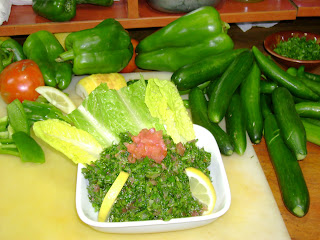Kindly note that you can follow these recommendations to have cleaned vegetables:
-Wash your hands for 20 seconds with warm water and soap before and after preparing fresh produce.
-Cut away any damaged or bruised areas before preparing or eating.
-Gently rub produce while holding under plain running water. There’s no need to use soap or a produce wash.
-Wash produce BEFORE you peel it, so dirt and bacteria aren’t transferred from the knife onto the fruit or vegetable.
-Use a clean vegetable brush to scrub firm produce, such as melons and cucumbers.
-Dry produce with a clean cloth or paper towel to further reduce bacteria that may be present.
-Throw away the outermost leaves of a head of lettuce or cabbage.
The following link is an explanatory video on how to prepare Tabouli :





